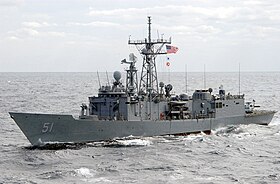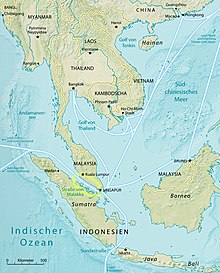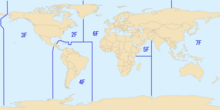USS Gary (FFG-51)
 The USS Gary at sea in 2003 |
|
| Overview | |
|---|---|
| Order | May 22, 1981 |
| Keel laying | 18th December 1982 |
| Launch | November 19, 1983 |
| 1. Period of service |
|
| Commissioning | 17th November 1984 |
| Decommissioning | 5th August 2015 |
| Technical specifications | |
| displacement |
4166 tons |
| length |
138.1 meters |
| width |
13.5 meters |
| Draft |
7.5 meters |
| crew |
19 officers, 200 sailors |
| drive |
2 × General Electric LM2500-30 41,000 shp (31 MW) gas turbines on one shaft with adjustable screw |
| speed |
29+ knots (54 km / h; 33 mph) |
| Armament |
1 × OTO Melara Mk 75 76 mm / L62 ship gun, |
The USS Gary (FFG-51) is a Lenkkörper- frigate of the US Navy and is part of the Oliver Hazard Perry-class frigate . She is the 41st ship in the class. The ship was sold to Taiwan in 2017 and is now named PFG-1112 Feng Chia ( 逢甲 ).
technology
The Garry is counted among the so-called long-hull , i.e. that is, it is about 138 meters long and 13 meters wide. She has a draft of 7 meters. Around 240 people work on the ship, including around 219 crew members and 21 members of the helicopter crews (six pilots, 15 maintenance personnel).
The Garry , like all ships of the Perry class, was initially designed primarily as an escort ship for defense against air and sea targets. For this purpose, she was equipped with an MK13 launcher for SM1 missiles for anti-aircraft missiles and Harpoon missiles for combating sea targets, which, however, was removed at the beginning of the 21st century. The Garry still has a single 76 mm gun and two torpedo tubes that can be used against submarines for anti- naval targeting . In addition, the ship has a CIWS for defense against approaching anti-ship missiles .
In addition, there are two SH-60 Seahawk helicopters on the USS Garry , which are suitable for combating surface targets and submarines and which can be equipped with Penguin anti-ship missiles and torpedoes .
Name and insignia
The ship was named after Donald Arthur Gary (1903-1977). Gary received the Medal of Honor for service in World War II . In March 1945 he was stationed on the USS Franklin in the Pacific when two bombs from a Japanese plane hit the Franklin .
The coat of arms of the Gary consists of a shield with helmet decoration, framed with the name and the identification of the ship. Under the sign is the frigate's motto, “Freedom's Foremost Guardian”.
history
The USS Gary was ordered in 1981. In December 1982, she was on set Kiel and after almost eleven months of construction at Todd Pacific Shipyards in San Pedro , from the pile left. The frigate was delivered on November 2, 1984 and put into service 15 days later. The ship is currently stationed in San Diego .
Calls
1985-1990
In January 1985 the ship was transferred to Pearl Harbor , her home port at the time. After a few tests and trips, the Gary was sent back to San Pedro, to Todd, to fix minor defects.
In the first half of 1986, the USS Gary sailed off the west coast of the USA and Hawaii . In June 1986 she took part in the RIMPAC exercise. After this mission, the ship and crew were sent to the Persian Gulf for the first time . On the way there, they made stops in Subic Bay , Singapore and Colombo . At the end of September they reached the Gulf of Oman . At the end of the year they were ordered back to the USA. In January 1987 they reached their new home port of Long Beach . The rest of the year the ship spent cruising offshore.
At the end of January 1988, the Gary sailed again with her sister ship USS Copeland in the direction of the Persian Gulf to support Operation Earnest Will . At the beginning of March they reached their area of operation. Their helicopters helped track down mines. During Operation Praying Mantis, the crew protect the two barges Hercules and Wimbrown 7 . In mid-June, the frigates left the Gulf together to return to the USA. On July 27th they reached Long Beach. The rest of the year she cruised off the coast of the United States.
The next half year the Gary mainly spent cruising off the US coast or about 130 km up the Columbia River . In September the frigate cast off for her next mission in the western Pacific and Persian Gulf with her sister ship USS McClusky . After stops in different ports, the ship reached the end of the Persian Gulf in October 1989 to take part again in Operation Earnest Will . After almost three months and 17 escort trips, she returned to the United States in mid-March 1990. She was then overtaken by Todd and resumed patrols off the coast of the USA.
1991-1996
In June 1991, after the Pinatubo volcano erupted , the crew helped evacuate soldiers from Subic Bay in Operation Fiery Vigil . Then she went back to the Persian Gulf, where she patrolled until mid-October. During these three months she docked in the ports of Abu Dhabi and Mina Sulman (Bahrain). Together with the Carrier Air Wing Eleven, she conducted an exercise with the Navy of the United Arab Emirates and Bahrain . She reached Long Beach in late November.
The USS Gary was relocated to the Persian Gulf in 1993. On the way they stopped at Pearl Harbor, Yokosuka and Phuket . Here she spent the turn of the year and did not return until six months later, this time to San Diego, to her new home port. During their deployment they controlled six ships in order to enforce the UN resolution against Iraq. They also made port visits to Pakistan , Australia and Fiji . She spent the remainder of 1994 driving off the coast of the United States and Mexico .
The next mission took place in July 1995. When the ship was back in the Persian Gulf at the end of September, a cable fire broke out on board. Three US Navy ships , the USS Tempest, USS Cyclone and USS Harry W. Hill, as well as a Qatar Coast Guard ship, rushed to aid the Gary . The frigate was towed into the port of Bahrain by the USNS Catawba . All repairs were completed by the end of November. On December 20, FFG-51 passed through the Strait of Hormuz and left the Persian Gulf. Ten days later she anchored off Thailand and visited the ports of Hong Kong and Pearl Harbor on the return voyage. At the end of January 1996 it ran back to San Diego.
1997-2002
In August 1997, the Gary cast off from San Diego to visit the Persian Gulf for the seventh time in its history. From the beginning of October she stayed here for three months before leaving the Gulf again. This time it stopped en route in Perth , Fremantle , Hobart and Suva before reaching the USA again in mid-February 1998.
At the end of May 1999 the frigate set out again. This time in conjunction with the dock landing ship USS Comstock , her sister ship the USS George Philip , and after a short stop in Pearl Harbor with the armored landing ship USS Frederick to take part in exercise CARAT'99 ( Cooperation Afloat Readiness and Training ). This group first drove towards Yokosuka and Okinawa . At the end of June they reached Sattahip in Thailand together. A few days later they were driving through the Straits of Malacca . The ships sailed to the port of Lumut and anchored there until the exercise began in early July. First, they performed some maneuvers with the Malaysian Navy . They carried out communication, gun and tactical exercises. They arrived in Singapore on July 11th. Then the group drove into the South China Sea . There they briefly joined the submarine USS Portsmouth . They practiced together with the Singapore Navy . At the end of July they returned to Thailand (excluding the Portsmouth ) to train with their navy . Here the aircraft carrier HTMS Chakri Naruebet joined them. After five days this exercise was over and with it the CARAT'99 . The Gary went to Yokosuka. The crews of the Gary switched to her sister ship, the USS Thach, and returned to the USA. The Gary remained stationed in Yokosuka with her new crew. The frigate then spent the rest of the year off the Philippines and Japan .
In the first half of 2000, FFG-51 entered the Gulf again and checked another 27 ships and evacuated the crew of a burning oil tanker. They returned to Yokosuka three months later, where they spent the rest of the year cruising off the coast of Japan and joint exercises with the Japanese Navy .
Between January and July 2001, the USS Gary joined the combat group around the USS Kitty Hawk . They carried out several maneuvers with the naval forces of Singapore, Thailand, Canada and Australia. At the beginning of June, the Gary sank the old cruiser USS Reeves with the destroyer USS John S. McCain , the cruiser USS Chancellorsville , and the Carrier Air Wing Five as part of a SINKEX . On October 1, the frigate was moved to Pakistan together with the Kitty Hawk and the destroyer USS Curtis Wilbur to support Operation Enduring Freedom . There she was deployed to protect the USS Peleliu . On December 24th, the Gary , Curtis Wilbur and Kitty Hawk returned to Yokosuka.
In 2002 the frigate was not used very much. She drove off the coast of Japan and performed various maneuvers.
2003-2008
During her mission in 2007, she was the first US warship to land in the port of Sihanoukville in Cambodia after the Vietnam War . On her return voyage she exchanged her home port with the destroyer USS McCampbell . Since then she has been stationed in San Diego again and reports to Destroyer Squadron 7 .
Later that year, she took the squadron and aircraft carrier USS Ronald Reagan off the coast of Hawaii to practice the final maneuvers for the next major relocation in the following year. In 2008 they were moved together to the area of the 7th fleet .
2009 – today
They have been operating in the western Pacific region since May 2009. In February 2011 the Gary was transferred to the 4th Fleet area to take part in the fight against drug-related crime . She secured over $ 100 million worth of drugs.
In 2012, the USS Gary took part in the RIMPAC exercise again. Since May 2017 the "USS Gary" is now under the name "Fengchia" in the Taiwanese Navy as a submarine hunter.
Others
In June 1989, Gary took part in the filming of the feature film Hunt for Red October . It represented the ship that presented the Red October after surfacing and took the crew on board. In the film, however, she was run as her sister ship the Reuben James .
Web links
- Entry in the Naval Vessel Register on nvr.navy.mil
Individual evidence
- ↑ Keoni Everington: Two Perry-class frigates to be commissioned by Taiwan Navy in Nov. Taiwan News, October 1, 2018, accessed on November 6, 2018 .
- ↑ Section refers to fas.org
- ↑ name of the ship on navysite.de. Retrieved July 7, 2012 . (closely.)
- ↑ trips in 1985 to navy.mil. (PDF; 77 kB) Accessed July 7, 2012 . (closely.)
- ↑ rides 1986 navy.mil. (PDF; 172 kB) Accessed July 7, 2012 . (closely.)
- ↑ Journeys in 1988 on navy.mil. (PDF; 336 kB) Accessed July 7, 2012 . (closely.)
- ↑ rides 1989 navy.mil. (PDF; 251 kB) Accessed July 7, 2012 . (closely.)
- ↑ Journeys in 1990 on navy.mil. (PDF; 420 kB) Accessed July 7, 2012 . (closely.)
- ↑ rides 1991 navy.mil. (PDF; 441 kB) Retrieved July 8, 2012 . (closely.)
- ↑ rides 1993 navy.mil. (PDF; 104 kB) Retrieved July 8, 2012 . (closely.)
- ↑ 1994 trips on navy.mil. (PDF; 784 kB) Retrieved July 8, 2012 . (closely.)
- ↑ rides 1995 navy.mil. (PDF; 407 kB) Retrieved July 8, 2012 . (closely.)
- ↑ Rides 1999 on navy.mil. (PDF; 178 kB) Retrieved July 14, 2012 . (closely.)
- ↑ Rides 2000 on navy.mil. (PDF; 111 kB) Retrieved July 16, 2012 . (closely.)
- ↑ 2001 trips on navy.mil. (PDF; 135 kB) Retrieved July 16, 2012 . (closely.)
- ↑ New home port. Retrieved July 19, 2012 . (closely.)
- ↑ Journey in 2011. Retrieved on July 19, 2012 . (closely.)
- ↑ http://www.chinapost.com.tw/taiwan/detail.asp?id=497349&grp=%27B%27
- ↑ http://www.navsource.org/archives/07/0751.htm






